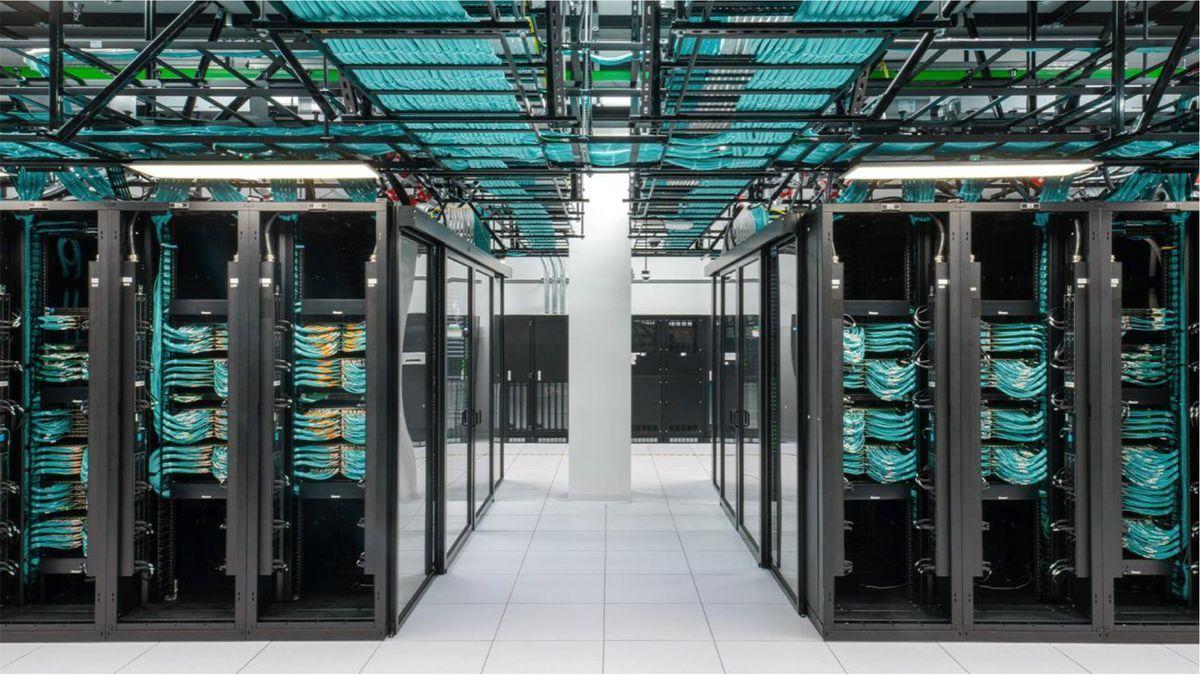UALink 1.0 Specification Released: A New Era of Open AI Accelerator Connectivity
2 Sources
2 Sources
[1]
UALink has Nvidia's NVLink in the crosshairs -- final specs support up to 1,024 GPUs with 200 GT/s bandwidth
One of the key aims of UALink is enabling a competitive connectivity ecosystem for AI accelerators that will rival Nvidia's established NVLink technology that enables the green company to build rack scale AI-optimized solutions, such as Blackwell NVL72. With the emergence of UALink 1.0, companies like AMD, Broadcom, Google, and Intel will also be able to build similar solutions, using industry-standard technologies rather than Nvidia's proprietary solutions, which means lower costs. The Ultra Accelerator Link Consortium on Tuesday officially published the final UALink 1.0 specification, which means that members of the group can now proceed with tape outs of actual chips supporting the new technology. The new interconnect technology targets AI and HPC accelerators and is supported by a broad set of industry players -- including AMD, Apple, Broadcom, and Intel. It promises to become the de facto standard for connecting such hardware. The UALink 1.0 specification defines a high-speed, low-latency interconnect for accelerators, supporting a maximum bidirectional data rate of 200 GT/s per lane with signaling at 212.5 GT/s to accommodate forward error correction and encoding overhead. UALinks can be configured as x1, x2, or x4, with a four-lane link achieving up to 800 GT/s in both transmit and receive directions. One UALink system supports up to 1,024 accelerators (GPUs or other) connected through UALink Switches that assign one port per accelerator and a 10-bit unique identifier for precise routing. UALink cable lengths are optimized for <4 meters, enabling <1 µs round-trip latency with 64B/640B payloads. The links support deterministic performance across one to four racks. The UALink protocol stack includes four hardware-optimized layers: physical, data link, transaction, and protocol. The Physical Layer uses standard Ethernet components (e.g., 200GBASE-KR1/CR1) and includes modifications for reduced latency with FEC. The Data Link Layer packages 64-byte flits from the transaction layer into 640-byte units, applying CRC and optional retry logic. This layer also handles inter-device messaging and supports UART-style firmware communication. The Transaction Layer implements compressed addressing, streamlining data transfer with up to 95% protocol efficiency under real workloads. It also enables direct memory operations such as read, write, and atomic transactions between accelerators, preserving ordering across local and remote memory spaces. As it's aimed at modern data centers, the UALink protocol supports integrated security and management capabilities. For example, UALinkSec provides hardware-level encryption and authentication of all traffic, protecting against physical tampering and supporting Confidential Computing through tenant-controlled Trusted Execution Environments (such as AMD SEV, Arm CCA, and Intel TDX). The specification allows Virtual Pod partitioning, where groups of accelerators are isolated within a single Pod by switch-level configuration to enable concurrent multi-tenant workloads on a shared infrastructure. UALink Pods will be managed via dedicated control software and firmware agents using standard interfaces like PCIe and Ethernet. Full manageability is supported through REST APIs, telemetry, workload control, and fault isolation. "With the release of the UALink 200G 1.0 specification, the UALink Consortium's member companies are actively building an open ecosystem for scale-up accelerator connectivity," said Peter Onufryk, UALink Consortium President. "We are excited to witness the variety of solutions that will soon be entering the market and enabling future AI applications." Nvidia currently dominates in the AI accelerator market, thanks to its robust ecosystem and scale-up solutions. It's currently shipping Blackwell NVL72 racks that use NVLink to connect up to 72 GPUs in a single rack, with inter-rack pods allowing for up to 576 Blackwell B200 GPUs in a single pod. With its upcoming Vera Rubin platform next year, Nvidia intends to scale up to 144 GPUs in a single rack, while Rubin Ultra in 2027 will scale up to 576 GPUs in a single rack.
[2]
The No-Nvidia networking club delivers first spec
No-Nvidia networking club is banking on you running different GPUs on one network The Ultra Accelerator Link Consortium has delivered its first GPU interconnect specification: UALink 200G 1.0. The Consortium (UAC) was formed in May 2024 by a group of vendors - among them AMD, AWS, Broadcom, Cisco, Google, HPE, Intel, Meta, Microsoft, and Astera Labs - who think the world needs an open alternative to Nvidia's NVLink tech that allows creation of the networked GPU clusters needed to run AI workloads at scale. Members aren't just advancing the cause of open standards. Nvidia's networking business won over $13 billion in revenue in its last financial year, and the GPU giant has signaled its intention to grow that business. UALink's members fancy creating a cheaper alternative they can control and deploy themselves at hyperscale, or profit from by creating hardware the rest of us buy. They also think the world is ready for a networking standard that can be applied to GPUs from multiple vendors rather than requiring users to create network silos dedicated to each accelerator vendor. To satisfy those goals, the UAC also wants to work over the Ethernet networks most orgs already operate. UALink 200G 1.0, as the name implies, enables a 200 Gbps (gigabits per second) connection to an accelerator. It can also quadruple that speed by allowing four connections to each GPU. The spec allows creation of compute pods packing 1,024 accelerators and achieving what the consortium describes as "the same raw speed as Ethernet with the latency of PCIe switches." All while consuming somewhere between a third and a half of a typical Ethernet network. That's a lot to get done in under a year, but UAC didn't start from scratch. Chair and director Kurtis Bowman told The Register the spec draws very heavily on AMD's existing Infinity Fabric product. "We were able to build on that [Infinity Fabric]," he told The Register, but also used tech from other UAC members who have cooked their own networking stacks to address their own needs. "Intel, Google, and Microsoft said 'we have challenges in our datacenters and we need you to address that,'" Bowman said. He admitted it will be around 18 months before compliant hardware goes on sale but thinks that's six months less than is typically required to turn a spec into product. Bowman thinks the likes of HPE, Dell, and Lenovo will adopt the spec and deliver AI solutions that employ it, as will the likes of Broadcom and Synopsys as they create custom accelerators for hyperscale customers. Work on a second spec is already underway to take advantage of 400G Ethernet variants as they go mainstream. ®
Share
Share
Copy Link
The Ultra Accelerator Link Consortium has released the final UALink 1.0 specification, challenging Nvidia's NVLink with an open standard for high-speed, low-latency AI accelerator connectivity. This development promises to reshape the AI hardware landscape.

UALink 1.0: A New Standard in AI Accelerator Connectivity
The Ultra Accelerator Link Consortium has officially released the final UALink 1.0 specification, marking a significant milestone in the development of open standards for AI accelerator connectivity. This new technology aims to challenge Nvidia's proprietary NVLink, offering a competitive alternative for high-performance computing and AI applications
1
2
.Technical Specifications and Capabilities
UALink 1.0 boasts impressive technical specifications:
- Maximum bidirectional data rate of 200 GT/s per lane
- Support for up to 1,024 accelerators in a single system
- Configurable links (x1, x2, or x4) with up to 800 GT/s in both directions
- Optimized for <4 meter cable lengths with <1 µs round-trip latency
- Four hardware-optimized layers: physical, data link, transaction, and protocol
1
The new standard leverages standard Ethernet components while introducing modifications for reduced latency. It also implements compressed addressing, achieving up to 95% protocol efficiency under real workloads
1
.Security and Management Features
UALink 1.0 incorporates advanced security and management capabilities:
- UALinkSec for hardware-level encryption and authentication
- Support for Confidential Computing through tenant-controlled Trusted Execution Environments
- Virtual Pod partitioning for isolated accelerator groups
- Full manageability through REST APIs, telemetry, and workload control
1
Related Stories
Industry Impact and Competition with Nvidia
The release of UALink 1.0 is set to reshape the AI accelerator market:
- Enables companies like AMD, Broadcom, Google, and Intel to build rack-scale AI solutions
- Offers an open alternative to Nvidia's proprietary NVLink technology
- Potential for lower costs due to the use of industry-standard technologies
1
2
Nvidia currently dominates the market with solutions like Blackwell NVL72, which can connect up to 72 GPUs in a single rack. The company plans to scale up to 576 GPUs in a single rack by 2027 with its Vera Rubin Ultra platform
1
.Consortium Members and Future Developments
The Ultra Accelerator Link Consortium includes major players such as AMD, AWS, Broadcom, Cisco, Google, HPE, Intel, Meta, and Microsoft. The specification draws heavily on AMD's existing Infinity Fabric product while incorporating technologies from other members
2
.Kurtis Bowman, Chair and Director of UAC, expects compliant hardware to be available in about 18 months. Major vendors like HPE, Dell, and Lenovo are anticipated to adopt the spec for their AI solutions
2
.Work on a second specification is already underway, aiming to take advantage of 400G Ethernet variants as they become mainstream
2
.As the AI hardware landscape continues to evolve, UALink 1.0 represents a significant step towards open standards and increased competition in the high-performance computing sector.
References
Summarized by
Navi
[1]
[2]
Related Stories
UALink Consortium Incorporates to Challenge Nvidia's Dominance in AI Interconnect Technology
31 Oct 2024•Technology

Broadcom's Tomahawk Ultra: Revolutionizing Ethernet for AI and HPC
16 Jul 2025•Technology

Apple Joins UALink Consortium to Shape Future of AI Accelerator Interconnections
15 Jan 2025•Technology

Recent Highlights
1
Meta acquires Manus for $2 billion, adding revenue-generating AI agents to its platforms
Business and Economy

2
China proposes world's strictest AI chatbot rules to prevent suicide and emotional manipulation
Policy and Regulation

3
Deepfakes cross indistinguishable threshold as voice cloning and video realism surge 900%
Technology




